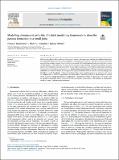Files in this item
Modelling rheumatoid arthritis : a hybrid modelling framework to describe pannus formation in a small joint
Item metadata
| dc.contributor.author | Macfarlane, Fiona R. | |
| dc.contributor.author | Chaplain, Mark A.J. | |
| dc.contributor.author | Eftimie, Raluca | |
| dc.date.accessioned | 2022-05-16T12:31:21Z | |
| dc.date.available | 2022-05-16T12:31:21Z | |
| dc.date.issued | 2022-06 | |
| dc.identifier | 279614865 | |
| dc.identifier | b30fb68f-d4cc-43ed-9a56-cc31af52b89e | |
| dc.identifier.citation | Macfarlane , F R , Chaplain , M A J & Eftimie , R 2022 , ' Modelling rheumatoid arthritis : a hybrid modelling framework to describe pannus formation in a small joint ' , ImmunoInformatics , vol. 6 , 100014 . https://doi.org/10.1016/j.immuno.2022.100014 | en |
| dc.identifier.issn | 2667-1190 | |
| dc.identifier.other | RIS: urn:0EB5E1D2DB820D7260D4F20C2F90A16C | |
| dc.identifier.other | ORCID: /0000-0003-2242-7745/work/113398368 | |
| dc.identifier.other | ORCID: /0000-0001-5727-2160/work/113398709 | |
| dc.identifier.uri | https://hdl.handle.net/10023/25378 | |
| dc.description.abstract | Rheumatoid arthritis (RA) is a chronic inflammatory disorder that causes pain, swelling and stiffness in the joints, and negatively impacts the life of affected patients. The disease does not have a cure yet, as there are still many aspects of this complex disorder that are not fully understood. While mathematical models can shed light on some of these aspects, to date there are few such models that can be used to better understand the disease. As a first step in the mechanistic understanding of RA, in this study we introduce a new hybrid mathematical modelling framework that describes pannus formation in a small proximal interphalangeal (PIP) joint. We perform numerical simulations with this new model, to investigate the impact of different levels of immune cells (macrophages and fibroblasts) on the degradation of bone and cartilage. Since many model parameters are unknown and cannot be estimated due to a lack of experiments, we also perform a sensitivity analysis of model outputs to various model parameters (single parameters or combinations of parameters). Finally, we discuss how our model could be applied to investigate current treatments for RA, for example, methotrexate, TNF-inhibitors or tocilizumab, which can impact different model parameters. | |
| dc.format.extent | 20 | |
| dc.format.extent | 6323554 | |
| dc.language.iso | eng | |
| dc.relation.ispartof | ImmunoInformatics | en |
| dc.subject | Rheumatoid arthritis | en |
| dc.subject | Hybrid model | en |
| dc.subject | Stochasticity | en |
| dc.subject | Immune response | en |
| dc.subject | QA75 Electronic computers. Computer science | en |
| dc.subject | QR180 Immunology | en |
| dc.subject | DAS | en |
| dc.subject.lcc | QA75 | en |
| dc.subject.lcc | QR180 | en |
| dc.title | Modelling rheumatoid arthritis : a hybrid modelling framework to describe pannus formation in a small joint | en |
| dc.type | Journal article | en |
| dc.contributor.institution | University of St Andrews. Applied Mathematics | en |
| dc.contributor.institution | University of St Andrews. School of Mathematics and Statistics | en |
| dc.identifier.doi | https://doi.org/10.1016/j.immuno.2022.100014 | |
| dc.description.status | Peer reviewed | en |
This item appears in the following Collection(s)
Items in the St Andrews Research Repository are protected by copyright, with all rights reserved, unless otherwise indicated.

